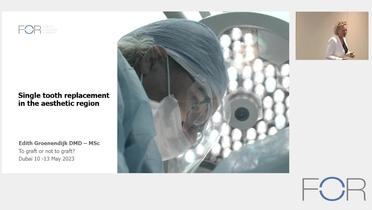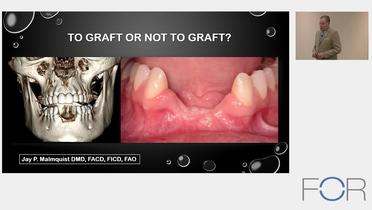Grafting or Graftless - different treatment approaches for multiple missing teeth
Video highlights
- Grafting vs. preservation
- Treatment options for the aesthetic region in the maxilla
- Treatment options for the posterior maxilla
In the third and last part of our series on graftless and graft solutions for patients with missing teeth, Dr. Edith Groenendijk continues the presentation with a new case. She discusses a young trauma patient who visited her clinic after a bike accident, resulting in the loss of one of his central incisors in the maxilla. Dr. Groenendijk presents the initial images and invites the audience to consider their preferred treatment for such a trauma case. She outlines the following three options:
- Option: follow a delayed protocol and graft
- Option: follow a delayed protocol and preserve
- Option: follow an immediate protocol and preserve
As the presentation progresses, she reveals additional information about the patient situation at initial assessment: the patient also presented with serious fractures to his premaxilla. With this important presenting complexity, Dr. Groenendijk decided to proceed with a ridge preservation instead of an immediate implant placement. The ridge preservation approach allows for other treatments, such as grafting, if the preservation does not lead to the desired results. A natural healing in such a case would result in a large defect. A ridge preservation is considered to be a simple and non-invasive treatment and the implant is later placed without the raising of a flap.
In this particular case Dr. Groenendijk thoroughly cleaned the socket and filled it with bovine bone substitute. She only closes the socket if it is not possible to place a resin-bonded provisional. After 6 months of healing, Dr. Groenendijk placed the implant in position # 11. During this healing period a small gain in the height of the soft tissue was observed, although there was a minor loss of horizontal volume – both of which are typical after a ridge preservation procedure. The implant bed was prepared transmucosally, and a hand driver was used to place the implant. Doing this, Dr. Groenendijk ensured that the implant was not placed too much to the buccal aspect. In immediate cases the palatal wall is visible making it is easier to place the implant. While placing an implant after a ridge preservation makes is more challenging, as the drilling is performed in a straight fashion, and there is a risk placing the implant too buccally. The implant is restored with a temporary crown, already resulting in a satisfactory aesthetic outcome. Literature confirms this result, by demonstrating that a very high pink aesthetic score can be achieved with a ridge preservation before an implant placement.
To further improve clinical outcomes, Dr. Groenendijk also shares her experience educating referring dentists on how to handle teeth that need to be extracted. She recommends them to never extract a tooth before she has had a chance to examine the patient. This approach provides her with the options to work either with a minimally invasive or to perform a delayed protocol. [BR1]
Following Dr. Groenendijk's presentation, Dr. Ana Ferro takes the stage with a new case.. The patient presented with a very large bridge in the second quadrant (teeth 23-28), complaining about separation, taste, food impactions and mobility of the bridge. Upon examination, Dr. Ferro noticed bleeding around teeth #27 & 28, as well as pocket depths of more than 7 mm. The x-ray and CBCT confirm that teeth 27 & 28 could not be saved, but there was sufficient bone around tooth #25.
Dr. Ferro presents various treatment options to the audience and asks them to select their preferred option:
- Extraction 27&28, 4 months sinus lift, 6 months implant placement 25 & 27, 6 months 3-unit bridge
- Extraction 27&28, 4 months sinus lift, 6 months implant placement 25 & 27 and immediate 3-unit bridge
- Extraction 27&28 and sinus lift, 6 months implant placement and immediate 3-unit bridge
- Extraction 27&28 and implant placement 25 and tuberosity implant and immediate 3-unit bridge
The answers vary, and Dr. Ferro points out that the choice of the treatment depends on individual clinicians different backgrounds, as well as on their experience with different implant and materials. Additionally, the patient requested fixed teeth as he is a businessman. She shares that most of the treatments in her clinic are done with tilted implants, which has shown high success rates in meta-analyses and systemic reviews with minimal complications associated (see references).
Dr. Ferro opted for the fourth treatment option for the patient. On the same day, the metal ceramic bridge was cut distal to tooth number 24, teeth # 27&28 were extracted, an implant was placed on # 25 and a tuberosity implant on #27, porovisionalized with an immediate acrylic bridge. The final restoration was completed after 4 months. When recapping the surgical steps, Dr. Ferro highlights the importance of cleaning of the infection before implant placement as a crucial step. Multi-unit abutments were placed on # 25 with 0° and on #27 with 39° angulation to compensate for the tilting of the implant and achieve a passive fit of the restoration. An all-acrylic bridge was delivered on the day of the surgery. She concludes her case presentation with follow-up images of the final restoration.
Learn more from the session concluding remarks and the interactive Q&A with Dr. Malmquist, Dr. Groenendijk and Dr. Ferro.
References
[1] Krekmanov L, Kahn M, Rangert B, Lindström H. Tilting of posterior mandibular and maxillary implants for improved prosthesis support. Int J Oral Maxillofac Implants. 2000 May-Jun;15(3):405-14. PMID: 10874806.
[2] Aparicio C, Perales P, Rangert B. Tilted implants as an alternative to maxillary sinus grafting: a clinical, radiologic, and periotest study. Clin Implant Dent Relat Res. 2001;3(1):39-49. doi: 10.1111/j.1708-8208.2001.tb00127.x. PMID: 11441542.
[3] Maló P, Rangert B, Nobre M. "All-on-Four" immediate-function concept with Brånemark System implants for completely edentulous mandibles: a retrospective clinical study. Clin Implant Dent Relat Res. 2003;5 Suppl 1:2-9. doi: 10.1111/j.1708-8208.2003.tb00010.x. PMID: 12691645.
[4] Maló P, Rangert B, Nobre M. All-on-4 immediate-function concept with Brånemark System implants for completely edentulous maxillae: a 1-year retrospective clinical study. Clin Implant Dent Relat Res. 2005;7 Suppl 1:S88-94. doi: 10.1111/j.1708-8208.2005.tb00080.x. PMID: 16137093.
[5] Peñarrocha-Oltra D, Candel-Martí E, Ata-Ali J, Peñarrocha-Diago M. Rehabilitation of the atrophic maxilla with tilted implants: review of the literature. J Oral Implantol. 2013 Oct;39(5):625-32. doi: 10.1563/AAID-JOI-D-11-00068. Epub 2011 Nov 28. PMID: 22121829.
[6] Chrcanovic BR, Albrektsson T, Wennerberg A. Tilted versus axially placed dental implants: a meta-analysis. J Dent. 2015 Feb;43(2):149-70. doi: 10.1016/j.jdent.2014.09.002. Epub 2014 Sep 17. PMID: 25239770.




